As an occasional feature on TELOSscope, we highlight a past Telos article whose critical insights continue to illuminate our thinking and challenge our assumptions. Today, Frederick H. Pitts looks at Salvatore Veca’s “Value, Labor, and the Critique of Political Economy” from Telos 9 (Fall 1971).
Capital is dead labor which, vampire-like, lives only by sucking living labor, and lives the more, the more labor it sucks.
—Karl Marx, Capital
Salvatore Veca’s 1971 essay “Value, Labor, and the Critique of Political Economy” summarizes the treatment of contained and required labor in Adam Smith, David Ricardo, and Karl Marx. Most interesting is the manner in which Veca temporalizes this distinction in political economy. He draws our attention to the opposition between past labor and present, dead labor and living; namely, “the dominance of past, materialized, accumulated labor over immediate, living labor”:
Starting from the analysis of the typical character of labor, it is possible to reconstruct towards the surface of the system the progressive stratifications and determinations of a totality which must, however, be traced back to its base, i.e., to that unequal exchange which contaminates the world of commodities and which reveals the class violence, the elementary mechanism of exploitation, and the dominance of dead labor over living labor.
Veca presents the same temporal picture of past and present labor that moved Marx to crisscross Capital with a metaphorical cast of ghostly manifestations, vampires, and the undead. Veca’s paper suggests the extent to which Marx’s range of metaphors is no mere literary conceit, but rather it is a key feature of fundamental theoretical nodes in his critique of political economy. As we shall see, the specter of dead labor has deeper conceptual foundations in Marx’s forerunners, but this idea also has contemporary relevance with reference to present-day philosophical trends.
 According to Veca, Marx’s “reduction of labor to the level of a commodity” necessitates “its distinct treatment as an arena of class struggle between the forces of dead and living labor geared towards the production of the surplus.” Marx identified the exchange between capital and labor “as the relation between contained labor and required labor.” Thus, Marx preserves Smith’s original discrepancy between required and contained labor. He locates the discrepancy, however, not in the pure surface of exchange, but rather in “the process of the production of capital itself.”
According to Veca, Marx’s “reduction of labor to the level of a commodity” necessitates “its distinct treatment as an arena of class struggle between the forces of dead and living labor geared towards the production of the surplus.” Marx identified the exchange between capital and labor “as the relation between contained labor and required labor.” Thus, Marx preserves Smith’s original discrepancy between required and contained labor. He locates the discrepancy, however, not in the pure surface of exchange, but rather in “the process of the production of capital itself.”
For Smith, surplus value arose from the inequality between the labor embodied in a commodity, and the amount of labor its production commands in the marketplace; the dominance of required over contained labor was confined solely to the sphere of exchange.” While Veca asserts that Smith’s inequality is one between dead and living labor, the analysis is confined to the immediate appearances of exchange. According to Veca, it was Ricardo who, by turning to contained labor as the sole determinant of value, provoked awareness of the fact that “the labor objectified in the commodity must be considered both as present and as past labor which has been stored in ‘utensils, tools and means’ of production.” In so doing, Ricardo pushed political economy beyond the realm of pure exchange and the world of immediate appearances. Indeed, he reaches back into the original determinations of value that existed, and continue to persist, zombie-like, in the past. This new element—past labor—was considered the missing factor which, when combined with the contemporary labor expended in the production of the commodity, would come to explain the deficit and inequality in the reward and product of labor.
It fell to Marx to complete this appraisal of past labor in his exhumation of the capitalist corpse. Deep in the realm of production, required labor is seen as that exertion necessitated by the crystallization of previously expended, objectified labor in its many forms. The wage that provides for the workers subsistence, the capital at the disposal of the capitalist, the means of production which demand to be used in order to provide a return on the initial investment, rather than be left fallow to depreciate over time, are all at work here. These forces, and their effects, are nothing less than the congealed outcome of previously expended generalized labor, resurrected to haunt the present. Capital consists of a “social relation” whereby dead objectified labor exerts dominion over its living counterpart, increasing the proportion of the former accumulated in the hands of capitalists by intensifying and extending the exploitation of the worker. In this way, the past rules the present, and dead labor the living.
Scott Kirsch and Don Mitchell (2004) remark upon the ways in which the Marxian concept of dead labor presents fertile territory for comparison with actor-network theory, in which “the ‘non-human’ can have very real social effects.” Subsequent philosophical trends developing since Kirsch and Mitchell’s article was published, including speculative realism and object-oriented ontology, have continued advocating such a post-human emphasis upon the powers of non-human entities, championing a Weltanschauung in which any given item or object is seen as equally powerful and effective as another. The forms dead labor takes—machines, money and so on—fit the bill precisely for this world of things, in which the capacity of the human to possess ontological privilege over his or her fellow “things” is diminished such that the human agent becomes one thing among others, subject to the agency of the non-human objects with which their world is shared. However, the material forms which dead labor assumes—capital, wages, means of production—should not be reified as “things” per se. Their fetishization as such must be instead eschewed in favor of a perspective that endows the forms of dead labor with their true, relational status. It is with reference to its living counterpart that dead labor can be considered relational, and it is only by recruiting living labor to serve its needs that dead labor can exert any effect upon the world whatsoever. As Veca writes,
Capital is not a thing but coincides with a social relation whereby “living labor serves accumulated labor as a means for maintaining and multiplying the exchange value of the latter.” Capital is not objectified labor tout court: it is objectified labor which is exchanged in a certain way with living labor.
With the caveat that dead labor’s dualistic relationality be heeded, the way in which Marx’s use of the term ascribes power and agency to seemingly inert, non-human actors, however, suggests grounds for a productive compatibility with post- or anti-human turns in contemporary strands of continental philosophy.
The notion of dead labor bears implications for theories about capitalist crisis, the two reoccurring Marxian conceptualizations of which are overproduction and the falling rate of profit. First, crises of overproduction brings the accumulation of too great an inventory of commodities for the market to absorb, a congealed surplus of objectified past labor that acts as a burden upon the capitalist productive cycle. Second, where the falling rate of profit is concerned, Marx saw the central contradiction as lying in the organic composition of capital. This is the ratio between constant capital, representing all means of production, machinery and raw materials (i.e., dead labor), and variable capital, or human living labor. Initially, the influx of new and greater means of production into the labor process may intensify the control and domination to which the worker is subject (dead labor dominating living). However, the drive toward improving efficiency can result in the expulsion of living labor from production processes. This latter case sees dead labor act as a drag upon the creation of surplus value; the proportion of dead to living labor can be seen to rise, as either the amount of workers or the amount of hours worked decrease. The increase in the “social productivity of labor” prompted by the influx of new technology (congealed dead labor) into the production process at once promises the opening of the full potential of capitalist production, while simultaneously belying the destruction of the very foundation upon which it is established and maintained. This, according to Marx, starves capital of the one thing upon which it thrives: human, living, labor-time.
The opposition of dead and living labor has implications for political practice. Veca quotes an interesting passage from the Grundrisse, where Marx casts living labor as a “subjectivity” upon which, it is inferred, opposition to the forces of capital may be anchored; as Veca puts it, the “opposition of objectified labor and living labor,” “between past and present labor.” The political implication of this claim is that the real enemy of the worker is dead labor as represented in the means of production, the wage, and the wealth of the capitalist. Living labor is its revolutionary counterforce. However, as Moishe Postone (1993) has argued, a social relation, such as capitalism, cannot be negated by restating one half of it. As is repeatedly the case in Marx, a duality such as that between living and dead labor constitutes a unity. To follow the inference of Marx in the passage above, and to affirm living labor as a possible “opposition to capital,” is to ignore this dualistic quality. On the one hand, dead labor cannot be engaged productively without the living labor that it commands. On the other, to continue expending “living labor” is only to promise its crystallization as dead labor in the future; it cannot “live” indefinitely, and will one day die and come back to haunt the present. The attempted negation of dead labor through the celebration of living labor heralds only the liberation of labor as a productive potential unfettered by the husks of formerly expended effort that dominate the worker from beyond the grave. It might be argued that what is instead required is liberation from labor, which can only be realized in the destruction of both dead and living labor.
Bibliography
Kirsch, Scott, and Don Mitchell. “The Nature of Things: Dead Labor, Nonhuman Actors, and the Persistence of Marxism.” Antipode 36:4 (2004): 687–705.
Marx, Karl. Capital: A Critique of Political Economy. Vols. 1 and 3. London: Penguin, 1981–90.
Postone, Moishe. Time, Labor, and Social Domination: A Reinterpretation of Marx’s Critical Theory. Cambridge: Cambridge UP, 1993.
Read the full version of Salvatore Veca’s “Value, Labor, and the Critique of Political Economy” at the Telos Online website. If you are affiliated with an institution that is an online subscriber to Telos, you have free access to our complete online archive. If not, you can purchase 24-hour access to this and other Telos articles at a per-article rate. Follow the article link for more details.



